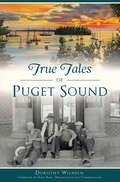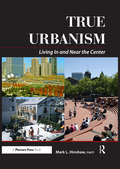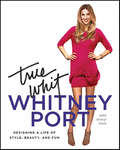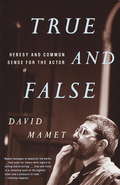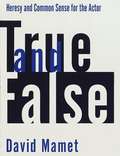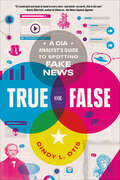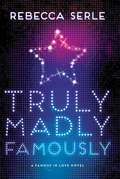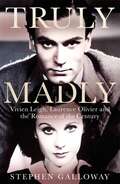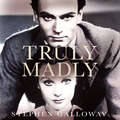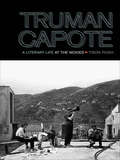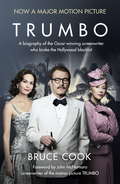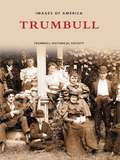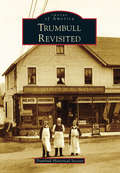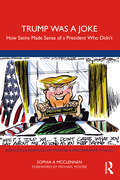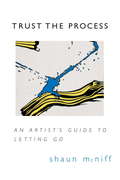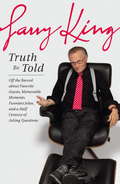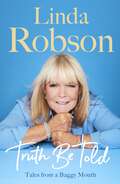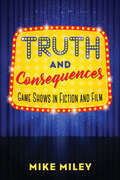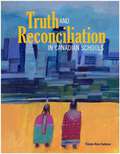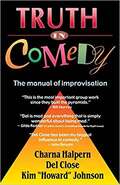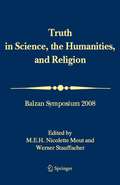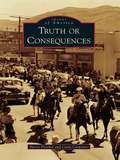- Table View
- List View
True Tales of Puget Sound (American Legends)
by Dorothy Wilhelm Dave Ross - Broadcaster and CommentatorFrom the shores of Gig Harbor to the slopes of Mount Rainier, the towns surrounding Puget Sound all have incredible stories to share. How did Old Fort Nisqually, now perched on a lofty bluff above Tacoma, move twenty-two miles from its original 1843 site in DuPont? Did Eatonville's copper-infused paint inspire the phrase "painting the town red"? Read about the famed Pie Goddess of Enumclaw and about a cookbook compiled by Emma Smith DeVoe of Parkland that included helpful tips from suffragettes. Join author Dorothy Wilhelm, of the television show My Home Town, as she explores these beloved town tales and uncovers the rest of the story.
True Urbanism: Living In and Near the Center
by Mark HinshawMark Hinshaw has a proposition for Americans: Come out of the bunker, throw open the gates, and meet the neighborhood. In this passionate appeal, he introduces those who have already done just that and explains what cities can do to make true urbanism possible. He rejoices in the growing number of people rejecting sterile, paint-by-numbers subdivisions in favor of vibrant and unpredictable urban neighborhoods. This vivid account of cities small and large emerging from the cobwebs of late 20th century development will show communities with lingering antiurban tendencies how to embrace density as destiny. A must-read urban design book for anyone who cares about cities.
True Whit: Designing a Life of Style, Beauty, and Fun
by Whitney PortWhitney Port shares personal stories, beauty and fitness secrets, and tried-and-true advice on everything girls need to know to start their lives out with styleFashion trendsetter, MTV reality star, and clothing designer Whitney Port learned to navigate her new independent life in New York with grace, style, and a sense of humor. From backstabbing coworkers and bitchy bosses to long-distance boyfriends and a daring new career in fashion, Whitney managed to handle it all. Intimate and honest, Whitney opens up about everything from fashion and beauty to romance and careers. She dishes on: her experiences working at Teen Vogue, People's Revolution, and Diane von Furstenberg; finding love and trying to make it work; and life in front of the cameras. Whitney shares her unique style philosophy, including when to break the rules, her family's influence on her sense of style, and her perfect outfits for any occasion—from meeting your guy's parents to wowing an interviewer for a job. Whitney also details what young women really want to know, like what to eat when the mid-afternoon munchies strike, how to throw an impromptu party, and how to hide a hangover.With hundreds of photos and chock-full of must-have lists and style favorites, this colorful scrapbook features pics from Whitney's personal photo albums and from major moments in her life, including on the runway, at her private birthday bash, and out on the town with friends. And for the first time, Whitney shares the true reality of an emerging fashion designer, highlighting her creative process, sketches, and fabrics.Through personal stories and private snapshots, fans will get to see a side of her that the cameras don't capture. This is Whitney Port revealed.
True and False
by David MametInvent nothing, deny nothing, speak up, stand up, stay out of school. With these words, one of our most brilliantly iconoclastic playwrights takes on the art of profession of acting, in a book that is as shocking as it is practical, as witty as it is instructive, and as irreverent as it is inspiring. Acting schools, "interpretation," "sense memory," "The Method"--David Mamet takes a jackhammer to the idols of contemporary acting, while revealing the true heroism and nobility of the craft. He shows actors how to undertake auditions and rehearsals, deal with agents and directors, engage audiences, and stay faithful to the script, while rejecting the temptations that seduce so many of their colleagues. Bracing in its clarity, exhilarating in its common sense, True and False is invaluable.From the Trade Paperback edition.
True and False: Heresy and Common Sense for the Actor
by David MametA guide into acting careers for aspirant actors, it helps in judging a role, approaching the part, working with the dramatist, going through auditions, and the industry in general.
True or False: A CIA Analyst's Guide to Spotting Fake News
by Cindy L. Otis"If I could pick one book to hand to every teen—and adult—on earth, this is the one. True or False is accessible, thorough, and searingly honest, and we desperately needed it." —Becky Albertalli, author of Simon vs. the Homo Sapiens Agenda A former CIA analyst unveils the true history of fake news and gives readers tips on how to avoid falling victim to it in this highly designed informative YA nonfiction title. "Fake news" is a term you’ve probably heard a lot in the last few years, but it’s not a new phenomenon. From the ancient Egyptians to the French Revolution to Jack the Ripper and the founding fathers, fake news has been around as long as human civilization. But that doesn’t mean that we should just give up on the idea of finding the truth.In True or False, former CIA analyst Cindy Otis will take readers through the history and impact of misinformation over the centuries, sharing stories from the past and insights that readers today can gain from them. Then, she shares lessons learned in over a decade working for the CIA, including actionable tips on how to spot fake news, how to make sense of the information we receive each day, and, perhaps most importantly, how to understand and see past our own information biases, so that we can think critically about important issues and put events happening around us into context.True or False includes a wealth of photo illustrations, informative inserts, and sidebars containing interesting facts and trivia sure to engage readers in critical thinking and analysis.This title has common core connections.
Truly Madly Famously (Famous in Love #2)
by Rebecca SerleSoon to be a series on Freeform, formerly ABC Family, starring Bella Thorne. "A must-read for anyone curious about life and love behind the scenes."--Bella Thorne, actor and author of Autumn Falls, on Famous in LoveLights, camera, love!After being plucked from obscurity, Hollywood's newest It Girl, Paige Townsen, has a blockbuster film to her name and Rainer Devon on her arm. But being half of the world's most famous couple comes with a price. No matter where Paige goes, someone is always watching. Soon she finds herself dodging photographers; hiding her feelings for her other costar, Jordan Wilder; and weathering tabloid scandals that threaten to tear her and Rainer apart--and end her career as quickly as it began.As she navigates her new L.A. life in this exciting sequel to Famous in Love, Paige finds that she doesn't know who to trust: Old friends could be betraying her secrets, and new friends are keeping secrets of their own.
Truly Madly: Vivien Leigh, Laurence Olivier and the Romance of the Century
by Stephen GallowayA sweeping and heartbreaking Hollywood biography about the passionate, turbulent marriage of Laurence Olivier and Vivien Leigh.As seen in the Daily Mail and Mail on SundayIn 1934, a friend brought fledgling actress Vivien Leigh to see Theatre Royal, where she would first lay eyes on Laurence Olivier in his brilliant performance as Anthony Cavendish. That night, she confided to a friend, he was the man she was going to marry. There was just one problem: she was already married-and so was he.TRULY, MADLY is the biography of a marriage, a love affair that still captivates millions, even decades after both actors' deaths. Vivien and Larry were two of the first truly global celebrities - their fame fueled by the explosive growth of tabloids and television, which helped and hurt them in equal measure. They seemed to have it all and yet, in their own minds, they were doomed, blighted by her long-undiagnosed mental-illness, which transformed their relationship from the stuff of dreams into a living nightmare.Through new research, including exclusive access to previously unpublished correspondence and interviews with their friends and family, author Stephen Galloway takes readers on a bewitching journey. He brilliantly studies their tempestuous liaison, one that took place against the backdrop of two world wars, the Golden Age of Hollywood and the upheavals of the 1960s - as they struggled with love, loss and the ultimate agony of their parting.
Truly Madly: Vivien Leigh, Laurence Olivier and the Romance of the Century
by Stephen GallowayA sweeping and heartbreaking Hollywood biography about the passionate, turbulent marriage of Laurence Olivier and Vivien Leigh.A New York Times bestsellerAs seen in the Daily Mail and Mail on SundayIn 1934, a friend brought fledgling actress Vivien Leigh to see Theatre Royal, where she would first lay eyes on Laurence Olivier in his brilliant performance as Anthony Cavendish. That night, she confided to a friend, he was the man she was going to marry. There was just one problem: she was already married-and so was he.TRULY, MADLY is the biography of a marriage, a love affair that still captivates millions, even decades after both actors' deaths. Vivien and Larry were two of the first truly global celebrities - their fame fueled by the explosive growth of tabloids and television, which helped and hurt them in equal measure. They seemed to have it all and yet, in their own minds, they were doomed, blighted by her long-undiagnosed mental-illness, which transformed their relationship from the stuff of dreams into a living nightmare.Through new research, including exclusive access to previously unpublished correspondence and interviews with their friends and family, author Stephen Galloway takes readers on a bewitching journey. He brilliantly studies their tempestuous liaison, one that took place against the backdrop of two world wars, the Golden Age of Hollywood and the upheavals of the 1960s - as they struggled with love, loss and the ultimate agony of their parting.
Truman Capote: A Literary Life at the Movies (The South on Screen)
by Tison PughThe author of Queer Chivalry presents a biographical study of the celebrity writer &“rich with insight into [his] literary and cinematic achievements&” (Publishers Weekly). Truman Capote&’s legacy is in many ways defined by his complex relationship with Hollywood. In Truman Capote: A Literary Life at the Movies, Tison Pugh explores the author and his literature through a cinematic lens, weaving elements of Capote&’s biography—including his flamboyant public persona and his friendships and feuds with notable stars—with critical analysis of the films, screenplays, and adaptations of his works. Capote&’s masterful prose made him an iconic twentieth century author, and his screenplays, including Beat the Devil, Indiscretion of an American Wife, and The Innocents, allowed him to collaborate with such Hollywood heavyweights as Humphrey Bogart, John Huston, and David O. Selznick. But the beloved and acclaimed adaptations of his literature, most notably Breakfast at Tiffany&’s and In Cold Blood, undercut his daring treatment of homosexuality in favor of heterosexual romance. Pugh demonstrates how Capote&’s gay southern identity influenced perceptions of his literature and its adaptations. Illuminating Capote&’s successes and disappointments in the film industry, Pugh delivers a revealing and nuanced portrait of the author&’s literary life.
Trumbo: A biography of the Oscar-winning screenwriter who broke the Hollywood blacklist - Now a major motion picture
by Bruce CookNOMINATED FOR OSCAR, BAFTA AND GOLDEN GLOBE AWARDS (BRYAN CRANSTON, BEST ACTOR)Dalton Trumbo was the central figure of the infamous 'Hollywood Ten,' the screenwriters who, during the McCarthy era, were charged by the House Committee on Un-American Acitivities for their associations with the Communist Party. Due to their refusal to cooperate during the investigation, Trumbo and his fellow screenwriters were declared in contempt of Congress and were ultimately blacklisted from Hollywood and some were even jailed. Although Trumbo was one of several hundred writers, directors, producers, and actors who were deprived of the opportunity to work in the motion picture industry from 1947 to 1960, he won an Oscar under the pseudonym Robert Rich for The Brave One in 1956, and he was the first to see his name on the big screen again in 1960 with Exodus, one of the year's biggest movies.All his life Trumbo was a radical of the homegrown, independent variety. From his early days in Colorado, where his grandfather was a county sheriff, to his time in Los Angeles, where he organized a bakery strike and was even a bootlegger, to his time as an author when he wrote the powerful pacifist novel Johnny Got His Gun, to his heyday as a top-paid (and frequently broke) Hollywood screenwriter-where his credits include Roman Holiday, Spartacus, Papillon, Lonely Are the Brave, Thirty Seconds Over Tokyo, The Brave One, and Kitty Foyle-his life rivaled anything he had created.Written with Dalton Trumbo's full cooperation, at a moment when he himself did not know how much time he had left, Trumbo is a candid tale of a colorful figure who was at the epicenter of a tumultuous period in recent American history.
Trumbull
by Trumbull Historical SocietyTrumbull, Connecticut, was a small community with a lush landscape spotted with farms and light industries before the era of World War II. After the war, many soldiers returned to the states and came to Trumbull looking for homes. The explosion of Trumbull's economic market caused much of the farmland to become housing developments to accommodate the veterans and their families. This volume of nearly two hundred images looks back at Trumbull during the quieter era between 1890 and 1940, before the town was flooded with the mad rush of people and businesses. These fifty years detail a history marked by the prosperous times of the early twentieth century, the pain and anguish of World War I, and the gloomy grip of the Depression. Small-town life comes alive in the faces and places of Trumbull, and these photographs and their stories take a reader back into a time that seems so much simpler than today's hustle and bustle.
Trumbull Revisited
by Trumbull Historical SocietyIncorporated in 1797, Trumbull, Connecticut, developed from a collection of farms and settlements in the area north of Stratford. Trumbull's neighborhoods reflect the varied identities of these early settlements. The Nichols area features homes dating as far back as the establishment of the Farm Highway, which was laid out in 1696 and remains the third-oldest thoroughfare in the state. In the now-forested Pequonnock Valley, a 19th-century rail bed ambles past the foundations of wool mills, paper mills, and gristmills that served the community through the 1800s. That same rail line carried thousands of fun seekers to the picnic pavilions, toboggan slide, and other attractions of Parlor Rock Amusement Park in the late 1800s. Just to the west of the valley, a small, surviving triangle of the Long Hill Green marks an area that once buzzed with the production of shirts, cigars, and carriages. Today, Trumbull continues to rediscover itself and frequently receives accolades as one of the state's most desirable communities in which to live and raise a family.
Trump Was a Joke: How Satire Made Sense of a President Who Didn’t (Routledge Advances in Theatre & Performance Studies)
by Sophia A McclennenWritten by a scholar of satire and politics, Trump Was a Joke explains why satire is an exceptional foil for absurd political times and why it did a particularly good job of making sense of Trump. Covering a range of comedic interventions, Trump Was a Joke analyzes why political satire is surprisingly effective at keeping us sane when politics is making us crazy. Its goal is to highlight the unique power of political satire to encourage critical thinking, foster civic action, and further rational debate in moments of political hubris and hysteria. The book has been endorsed by Bassem Youssef, who has been referred to as the “Jon Stewart of Egypt,” and Srdja Popovic, author of Blueprint for Revolution, who used satirical activism to bring down Serbian dictator Slobodan Milosevic. With a foreword by award-winning filmmaker, satirist, and activist Michael Moore, this study will be of interest to readers who follow politics and enjoy political comedy and will appeal to the communications, comedy studies, media studies, political science, rhetoric, cultural studies, and American studies markets.
Trump: The Presidential Photographs
by William MorrowThe definitive visual portrait of Donald J. Trump’s presidency, as seen through the lens of the Official White House Photographers.Selecting the finest images from the White House collection, Trump: A Presidential Portrait is a stunning all-access pass to the 45th presidency. These historic photos portray both the grandest and most intimate moments, offering an insider’s look beyond the gates of the White House, and behind closed doors of the Oval Office, the Situation Room, and Air Force One, as well as President Trump’s official trips across the nation and the world.Accompanied by quotations from the president’s speeches, Trump: A Presidential Portrait offers a unique window of many of the most consequential events of the Trump administration: the appointments of Supreme Court Justices Neil Gorsuch and Brett Kavanaugh, the construction of the border wall, the White House Situation Room on the day of the raid that killed ISIS leader al-Baghdadi, the seventy-fifth anniversary commemoration of D-Day, and leadership of the nation’s response to the coronavirus pandemic. We also see President Trump perform the solemn duties of the commander-in-chief: addressing the troops at military bases across the globe, awarding the Medal of Honor, visiting Arlington National Cemetery, bearing witness in the aftermath of natural disasters. And there are intimate, private scenes of the President and First Lady at the White House, as they entertain foreign dignitaries and share quiet moments with family.Featuring more than 250 photographs in gorgeous full-color, here is the first book to gather the official photographs of the Trump White House—and an essential visual documentary of American history.
Trust the Process
by Shaun McniffWhether in painting, poetry, performance, music, dance, or life, there is an intelligence working in every situation. This force is the primary carrier of creation. If we trust it and follow its natural movement, it will astound us with its ability to find a way through problems--and even make creative use of our mistakes and failures. There is a magic to this process that cannot be controlled by the ego. Somehow it always finds the way to the place where you need to be, and a destination you never could have known in advance. When everything seems as if it is hopeless and going nowhere . . . trust the process. Shaun McNiff is internationally recognized as a founder and leading figure in the arts and healing field. University Professor at Lesley University in Cambridge, Massachusetts, he is past president of the American Art Therapy Association and the author of several other books including Art As Medicine, Trust the Process, and Creating with Others .
Truth Be Told: Off the Record about Favorite Guests, Memorable Moments, Funniest Jokes, and a Half Century of Asking Questions
by Larry KingTruth Be Told is a revealing and irresistibly entertaining look back on Larry's remarkable run at CNN, and an honest look at Larry's own life behind the scenes. After more than a half-century of asking questions, Larry King suddenly found everyone wanted answers from him. Was Larry King Live, CNN's highest rated program, ending after three decades? Was Larry getting divorced again? The paparazzi aimed their cameras at Larry. Jay Leno and other late-night talk-show hosts were having fun at his expense. And a cloud of uncertainty hovered over CNN. All of this forced Larry to look at changes in all aspects of his life, ultimately leading to his decision to leave Larry King Live and devote more time to his marriage and children. Larry reflects on how much the world has changed around him over the course of his fifty-year career, and he has a lot to say about everything and everyone: from marriage, politics, sports, entertainment, to the justice system, broadcasting, and the American future. Truth Be Told is a candid and surprising look inside the monumental career of one of the most powerful and legendary talk-show hosts as he signs off from the nightly television program that has been close to all of our hearts.
Truth Be Told: Tales from a Baggy Mouth
by Linda RobsonTHE SUNDAY TIMES BESTSELLING HILARIOUS AND HEARTFELT MEMOIR FROM LINDA ROBSON__________Linda Robson’s nickname is Baggy Mouth for good reason.She may be one of the nation’s favourite TV personalities – whether playing Tracey Stubbs in Birds of a Feather or being a regular on Loose Women – but she can’t help hilariously oversharing. Luckily, this is an ideal trait for her first-ever memoir . . .Taking us back to the very beginning, growing up in a North London council house, Linda explains how she came to attend theatre school aged nine, where she met Pauline Quirke.As their friendship blossomed and evolved into a professional partnership, small parts in theatre and film productions culminated in the pair being cast in the enduring and beloved sitcom Birds of a Feather.With a wicked glint in her eye, Linda recounts the twists and turns of an actor’s life, sharing tales of backstage antics, on-set stories and demanding co-stars from across her her varied and celebrated career.However, it has not all been laughter, and she candidly talks about the struggles she’s faced in her personal life and the battles she has had to overcome. Yet her determination to pull herself back from the brink shows us that the tough times really do make us stronger.Truth Be Told is funny, warm and loose-lipped about a remarkable life well-lived.__________PRAISE FOR TRUTH BE TOLD'Searingly honest' The Mail
Truth and Consequences: Game Shows in Fiction and Film
by Mike MileyAlthough nearly every other television form or genre has undergone a massive critical and popular reassessment or resurgence in the past twenty years, the game show’s reputation has remained both remarkably stagnant and remarkably low. Scholarship on game shows concerns itself primarily with the history and aesthetics of the form, and few works assess the influence the format has had on American society or how the aesthetics and rhythms of contemporary life model themselves on the aesthetics and rhythms of game shows. In Truth and Consequences: Game Shows in Fiction and Film, author Mike Miley seeks to broaden the conversation about game shows by studying how they are represented in fiction and film. Writers and filmmakers find the game show to be the ideal metaphor for life in a media-saturated era, from selfhood to love to family to state power. The book is divided into “rounds,” each chapter looking at different themes that books and movies explore via the game show. By studying over two dozen works of fiction and film—bestsellers, blockbusters, disasters, modern legends, forgotten gems, award winners, self-published curios, and everything in between—Truth and Consequences argues that game shows offer a deeper understanding of modern-day America, a land of high-stakes spectacle where a game-show host can become president of the United States.
Truth and Reconciliation in Canadian Schools
by Pamela Rose ToulouseIn this book, author Pamela Rose Toulouse provides current information, personal insights, authentic resources, interactive strategies and lesson plans that support Indigenous and non-Indigenous learners in the classroom. This book is for all teachers that are looking for ways to respectfully infuse residential school history, treaty education, Indigenous contributions, First Nations/Métis/Inuit perspectives and sacred circle teachings into their subjects and courses. The author presents a culturally relevant and holistic approach that facilitates relationship building and promotes ways to engage in reconciliation activities.
Truth and Reconciliation in Canadian Schools
by Pamela Rose ToulouseIn this book, author Pamela Rose Toulouse provides current information, personal insights, authentic resources, interactive strategies and lesson plans that support Indigenous and non-Indigenous learners in the classroom. This book is for all teachers that are looking for ways to respectfully infuse residential school history, treaty education, Indigenous contributions, First Nations/Métis/Inuit perspectives and sacred circle teachings into their subjects and courses. The author presents a culturally relevant and holistic approach that facilitates relationship building and promotes ways to engage in reconciliation activities.
Truth and Reconciliation in Canadian Schools
by Pamela Rose ToulouseIn this book, author Pamela Rose Toulouse provides current information, personal insights, authentic resources, interactive strategies and lesson plans that support Indigenous and non-Indigenous learners in the classroom. This book is for all teachers that are looking for ways to respectfully infuse residential school history, treaty education, Indigenous contributions, First Nations/Métis/Inuit perspectives and sacred circle teachings into their subjects and courses. The author presents a culturally relevant and holistic approach that facilitates relationship building and promotes ways to engage in reconciliation activities.
Truth in Comedy: The Manual of Improvisation
by Mike Myers Arthur L. Zapel Charna Halpern Del Close Kim H. JohnsonWant to learn the improv techniques that helped Mike Myers, Chris Farley, John Belushi, and many others along the road to TV and film stardom? Then let two esteemed founders of long-form improvisational theatre, Del Close and Charna Halpern, teach you the "Harold." <p><p> This groundbreaking acting exercise emphasizes pattern recognition and subversion of the audience s expectations, which are important factors for making people laugh without ever telling a joke. It involves six to seven players and many kinds of scenes: games, monologues, songs, skits and more, all of which are bound to keep both actors and audience members guessing. <p><p> The Harold is non-linear entertainment that remembers everything and wastes nothing the key to successful improvising and has become a standard in comedy clubs and improv theatres around the globe.
Truth in Science, the Humanities and Religion
by International Balzan FoundationThe question of the meaning of "truth" is central to many areas of contemporary debate, whether between those subscribing to a post-Enlightenment view of the world and those who seek fundamental truth in religious texts, or between those maintaining that there are absolute truths and those believing facts to be social constructs. For some, the ultimate truth is revealed through religious faith and textual authority. Can this view be reconciled with an evidence-based, materialist, post-Enlightenment perspective of the truth as embraced by the natural sciences? If religion holds the key to the truth, which religion and which truths? What is the attitude of the humanities to the meaning of truth? Truth in the sciences and the humanities as well as in religion and theology is the central theme of this book based on the proceedings of a conference organized by the International Balzan Foundation. It contains the speakers' lectures, the corresponding reactions of the invited panel members as well as the general discussions. The reader can familiarize himself with views ranging from philosophy to religion, from mathematics, physics and cosmology to biological sciences, history, sociology and economics. The exceptional wide scope of the book, comprising arguments about truth in the sciences, the humanities as well as religion and theology together with the discussions between representatives of all these different fields, means that it is of interest to a professional as well as a general readership.
Truth or Consequences
by Cindy Carpenter Sherry Fletcher"Hot Springs, New Mexico, Ain't That Any More" was one of the headlines on April 4, 1950, in the Gallup Independent. As a publicity stunt, Ralph Edwards had invited a town to change its name to "Truth or Consequences," the name of his popular radio quiz show, and Hot Springs agreed to do so. Since the late 1800s, the area has attracted health seekers to bathe in and drink from the area's hot mineral springs. The region is home to Elephant Butte Dam and lake, completed in 1916, which remains one of the largest irrigation dams in the United States. Carrie Tingley Crippled Children's Hospital, built in 1937 by New Mexico governor Clyde Tingley, utilized the natural hot mineral waters to treat children with polio. From the placement of the Hot Springs Bathhouse and Commercial District on the State and National Register of Historic Places to the centennial celebration of Elephant Butte Dam, Truth or Consequences continues to grow and develop while still honoring its heritage.
